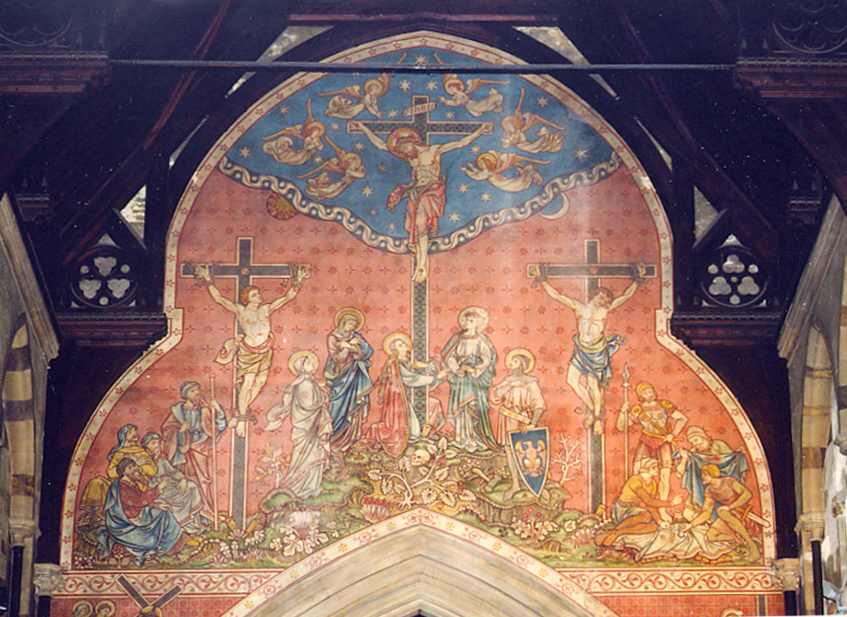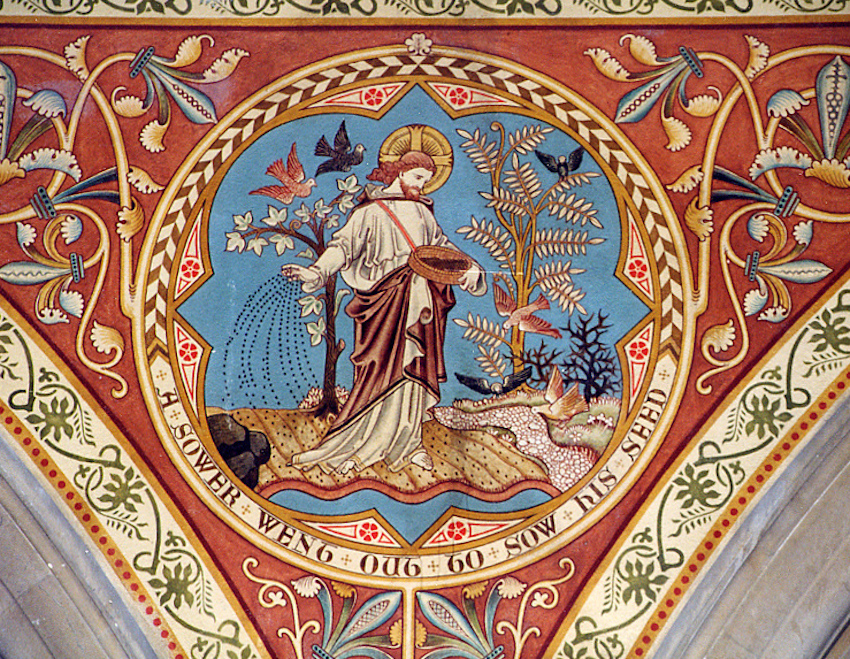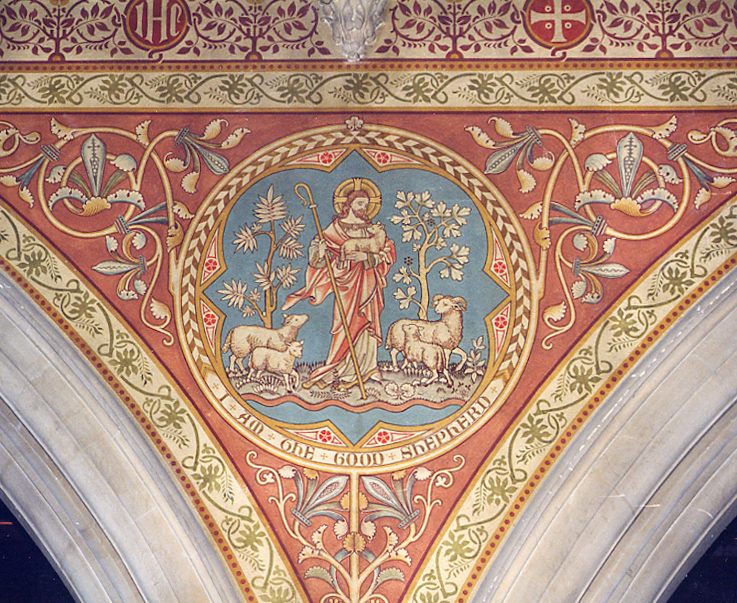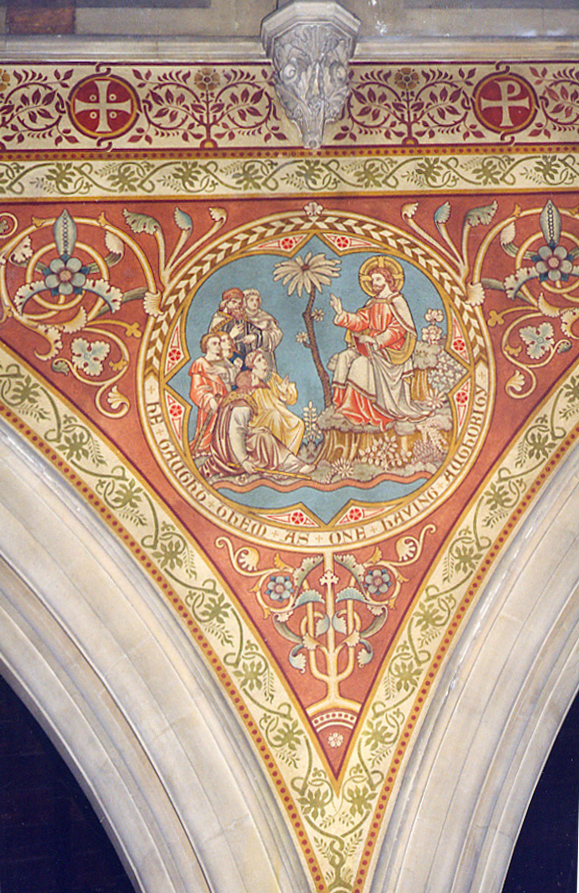Exterior


Left: Aerial view of the church, taken much earlier than the rest (1998), from the helium balloon that used to be tethered in the Lower Gardens, Bournemouth. Right: St Peter's from the south side, showing the gabled south porch and the two-light Geometrical windows, taken in August 2019.
St Peter's, Hinton Road, Bournemouth, a Grade I listed Victorian church with a complex building history. The south aisle was built on older foundations in 1851, by Edmund Pearce, described in the Post Office Directory of 1855 as an architect, surveyor and farmer of Canford Magna (21). His series of five two-light clerestory windows, linked by sandstone banding, seen on the right above, make a pleasing feature. But the Anglo-Catholic vicar of that time, the Reverend Alexander Morden Bennett (1808-1880), wanted to cater for a much larger congregation, and the distinguished London architect G. E. Street was asked to add to this. The church was then extended over a period of more than twenty years, from 1855-79, as funds became available. Built of Purbeck stone with Bath stone dressings, St Peter's acquired its large west tower in 1869, to which the landmark spire of just over 200 feet was added in 1879.
Nave


Left: Looking east to the sanctuary. Right: Looking towards the west end.
Below the impressively high hammer-beam roof, the nave of 1855-9 has five bays with "double-chamfered arches on octagonal colunms, black marble colonnettes to clerestory" (listing text). The wall painting was added in 1873-7 by Clayton and Bell, with the large chancel arch mural depicting the crucifixion, and a double series of medallions, in intricate floral surrounds, decorating the spandrels leading up to it.



Left to right: (a) The chancel arch. (b) "Jesus Stood on the Shore" (the Miraculous Draught of Fish). (c) "A Sower Went out to Sow His Seed" (the Parable of the Sower).



Left to right: (a) "From Henceforth Thou Shalt Catch Men." (b) "I Am the Good Shepherd." (c) He Taught Them as One Having Authority."
The medallions illustrate scenes from the life and teachings of Christ. Remarkable as it is, the effect of this mural painting is only the preliminary to the chancel and Keble Chapel to its south, in which, as Simon Jenkins says, "No inch is devoid of colour" (174).

Tracery detail of the decoratively designed clerestory lights.
Related Material
- St Peter's, Bournemouth: Part II (Choir and Sanctuary, Keble Chapel and Fittings)
- Windows here by Clayton & Bell
- Jesus on the Sea of Tiberias, by Edward Burne-Jones / Morris & Co.
- The Annunciation, by Sir John Ninian Comper
- South transept windows by Percy Bacon
- South aisle windows by William Wailes
- St Peter, Scenes after Pentecost, by James Clark & Eaton
You may use these images without prior permission for any scholarly or educational purpose as long as you (1) credit John Salmon and (2) link your document to this URL in a web document or cite the Victorian Web in a print one. [Click on the images to enlarge them and see the details.]
Bibliography
"About Us" St Peter's, Bournemouth. Web. 29 April 2020.
Blachford, John. St Peter's, Bournemouth. Norwich: Jarrold, 2006.
Butler, Perry. "Keble, John (1792–1866), Church of England clergyman and poet." Oxford Dictionary of National Biography. Web. 1 May. 2020.
"Church of St Peter." Historic England. Web. 29 April 2020.
Eberhard, Robert. "Stained Glass Windows at St Peter, Bournemouth" (recorded by Brian Woodruffe). Church Stained Glass Windows. Web. 29 April 2020.
Jenkins, Simon. England's Thousand Best Churches. Rev. ed. London: Penguin, 2009.
Pevsner, Nikolaus. The Buildings of England: Dorset. London: Penguin, 1972.
Post Office Directory of Hampshire, Wiltshire, and Dorsetshire, with Maps. London : Kelly & Co., 1855. Google Books. Free eBook.
Young, David S. The Story of Bournemouth. London: Robert Hale, 1957.
Last modified 14 May 2020